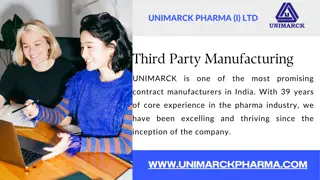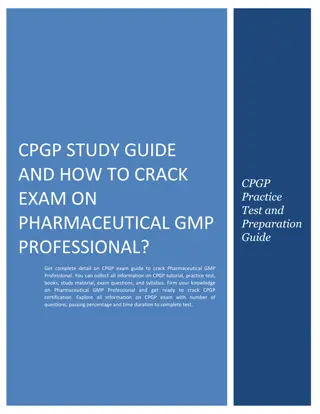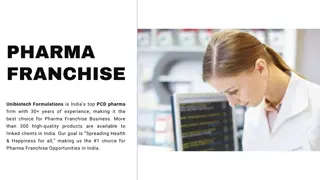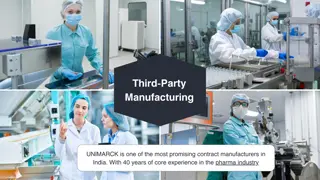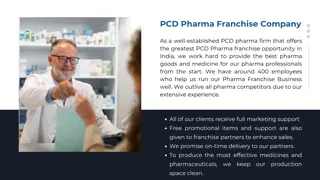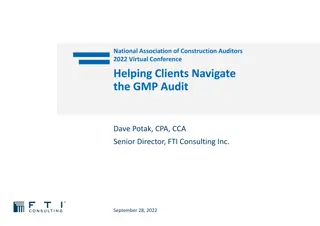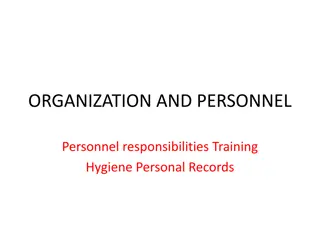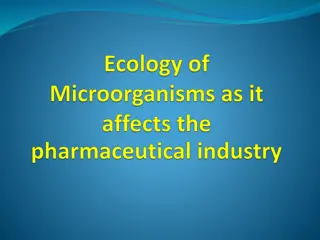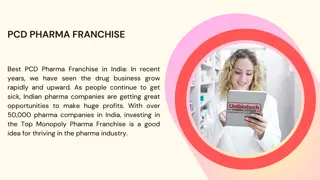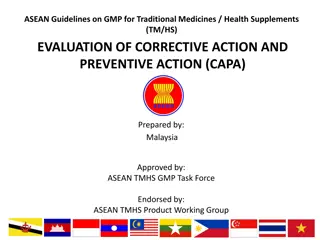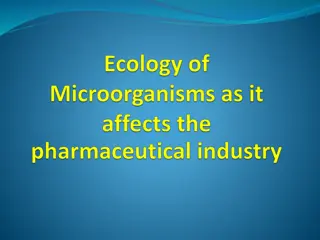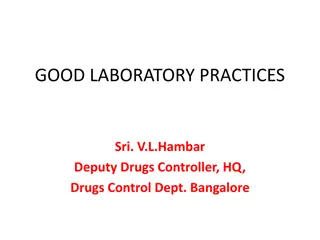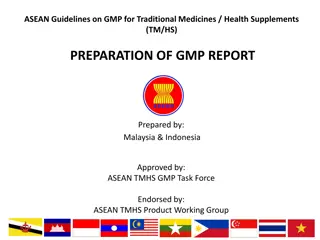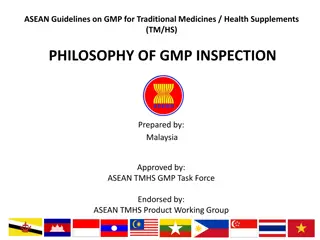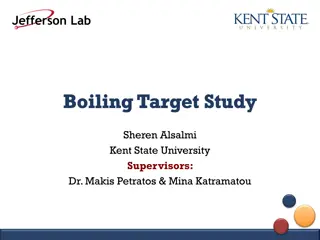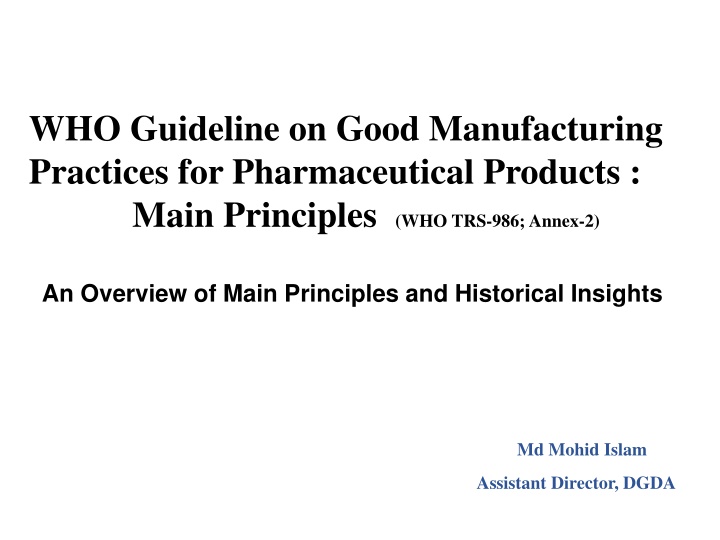
Historical Insights into the Birth of Good Manufacturing Practices in the Pharmaceutical Industry
Explore the tragic incidents of the 20th century that led to the establishment of Good Manufacturing Practices (GMP) for pharmaceutical products. Learn about key events such as the deaths caused by contaminated antitoxin and elixirs, which prompted regulatory actions and the implementation of quality control standards. Discover how these historical events shaped the foundation of GMP as we know it today.
Download Presentation

Please find below an Image/Link to download the presentation.
The content on the website is provided AS IS for your information and personal use only. It may not be sold, licensed, or shared on other websites without obtaining consent from the author. If you encounter any issues during the download, it is possible that the publisher has removed the file from their server.
You are allowed to download the files provided on this website for personal or commercial use, subject to the condition that they are used lawfully. All files are the property of their respective owners.
The content on the website is provided AS IS for your information and personal use only. It may not be sold, licensed, or shared on other websites without obtaining consent from the author.
E N D
Presentation Transcript
WHO Guideline on Good Manufacturing Practices for Pharmaceutical Products : Main Principles (WHO TRS-986; Annex-2) An Overview of Main Principles and Historical Insights Md Mohid Islam Assistant Director, DGDA
History of GMP References World Health Organization definition of GMP Legal Basis and Rationale Building Blocks of GMP Essential Elements of GMP Components of GMP (5P s) On-Site inspection and GMP 2|
Tragic incidents of 20thcentury vs. birth of GMP In 1901: Death of at least 12 children Children who received antitoxin for diphtheria treatment died of tetanus because the horse serum that had been used to prepare the antitoxin was contaminated with live tetanus bacilli. Regulation: Biologics Control Act of 1902 signed into law by President T. Roosevelt. Required inspections of manufacturers and sellers of biological products and testing of such products for purity and strength. The importance of quality of raw materials was demonstrated, along with the ability of animal-derived materials to pass diseases both known and unknown. 3|
Tragic incidents of 20thcentury vs. birth of GMP In 1937: 358 poisonings, 107 deaths (mostly children) and 251 sick but survived in an oral elixir of sulfanilamide Sulfanilamide was a drug in powder form used safely for years to treat streptococcal infections. However as there was a demand for liquid form. Elixir of sulfanilamide was a raspberry flavoured solution in a liquid industrial solvent, dietheylene glycol. Regulation: Federal Food, Drug and Cosmetic Act of 1938 signed by President F.Rossevelt For the first time, companies were required to prove that their products were safe before marketing them (FDAoverview). 4|
Tragic incidents of 20thcentury vs. birth of GMP In 1941: Almost 300 people killed or injured by one company s sulfathiazole tablets, a sulfa drug tainted with the sedative phenobarbital. Regulation: that incident caused FDA to drastically revise manufacturing and quality control requirements, leading to what would later be called GMPs. 5|
Tragic incidents of 20thcentury vs. birth of GMP In developed polio. 1955: 10 died and 51 children About 60 inoculated individuals, In 1955, Jonas Salk discovered a way to vaccinate against polio. Many manufacturers began making his polio inactivate the virus completely in a single lot. vaccine. One company failed to Several possible reasons: Inconsistent viral inactivation process. Quick scale-up production without proper validation of inactivation step. Active live virus production process used heat inactivation step. For virus scale-up of heat inactivation step may not have been sufficient. 6|
20th thcentury centuryvs. Tragic Tragicincidents incidentsof of20 vs. birth birthof GMP of GMP In 1960 s: Thalidomide was marketed in Europe as a sleeping pill and to treat morning sickness. deformities in developing fetuses. It caused serious Children whose mothers took thalidomide in the first trimester were born with severely deformed arms and legs. An estimated 10,000 cases of infant deformities in Europe were linked to thalidomide use. Regulation: companies required to ensure that the products were not only safe, but that they were efficacious for their intended uses. Regulating clinical trials, the amendments required drugs to be tested in animals before people. 7|
WHO-GMP History The first WHO draft text on good manufacturing practices (GMP) was prepared in 1967 (resolution WHA20.34) The first version of current Good Manufacturing Practices (GMP) for pharmaceutical products: Main Principles, published as Annex 3 in the WHO Technical Report Series, No. 961, 2011, The Revised Version published as Annex 2 in the WHO Technical Report Series, No. 986, 2014, which includes the following section- Section 1 : Pharmaceutical quality system Section 2 : Good manufacturing practices for pharmaceutical products Section 7 : Contract production, analysis and other activities Section 17: Good practices in quality control. 8
What is Good Manufacturing Practices? 9|
GMP is that part of QA which ensures that products are consistently produced and controlled the quality standards appropriate to to their intended use and as required by the marketing authorization. GMP are aimed primarily at diminishing the risks inherent in any pharmaceutical production. Quality can not be assessed, tested or inspected into the product, BUT it has to be built into it ! Such risks are essentiallyof two types: cross-contamination (in particular of unexpected contaminants) and mix ups (confusion) caused by, for example, false labels being put on containers. | 10 |
Why WHO-GMP? Legal Basis : - The Drugs Control Ordinance 1982 ; Article 15 (1) 11
Good Manufacturing Practices: Essential Elements (17) 1. PQS* 2. Good manufacturing practices for pharmaceutical products 3. Sanitation and hygiene 4. Qualification and validation 5. Complaints 6. Product recalls 7. Contract production and analysis 8. Self-inspection and quality audits 9. Personnel General Key personnel 10. Training 12
Good Manufacturing Practices (17) cont. 11. Personal hygiene 14. Materials and reworked materials Recalled products Returned goods Reagents and culture media Reference standards Waste materials Miscellaneous General Starting materials Packaging materials Intermediate and bulk products Finished products Rejected, recovered, reprocessed 12. Premises 13. Equipment 13
Good Manufacturing Practices (17) cont. 15. Documentation General Documents required: Labels Testing procedures Specifications for starting and packaging materials, for intermediate and bulk products and for finished products Master formulae and Batch Processing Records Packaging instructions and Batch Packaging Records Standard Operating procedures (SOP's) and records Logbooks 14
Good Manufacturing Practices (17) cont. 16. Good practices in production General Prevention of cross-contamination and bacterial contamination during production Processing operations Packaging operations 17. Good practices in quality control Control of starting materials and intermediate, bulk and finished products Test requirements Batch record review Stability studies 15
Quality management in the medicines industry Usually defined as the aspect of the management function that determines and implements the quality policy . The quality policy is a statement by the top management of the company of its overall intentions and direction relating to quality, formally expressed as a corporate policy. 17|
Quality Management (cont.) The basic elements of quality management are: an appropriate infrastructure or quality system , encompassing the organizational structure, procedures, processes and resources; systematic actions necessary to ensure adequate confidence that a product (or service) will satisfy given requirements for quality. The totality of these actions is termed QA . Within an organization, QA serves as a management tool. The concepts of QA, GMP, QC and quality risk management (QRM) are interrelated aspects of quality management and should be the responsibility of all personnel. 18|
Pharmaceutical Quality System (PQS*) Principle: The manufacturer must assume responsibility for the quality of the pharmaceutical products to ensure that they are fit for their intended use, comply with the requirements of the marketing authorization and do not place patients at risk due to inadequatesafety, quality or efficacy. (1.1) The attainment of the quality objective is the responsibility of senior management and requires the participation and commitment of everyone. To achieve this quality objective reliably there must be a comprehensively designed and correctly implemented pharmaceutical quality system (PQS) incorporating GMP and QRM 19
PQS (cont.) Senior management has the ultimate responsibility to ensure an effective PQS is in place, is adequately resourced, and that roles, responsibilities, and authorities are defined, communicated and implemented throughout the organization. Senior management s leadership and active participation in the PQS is essential. Quality management, therefore, incorporates GMP and other factors, including those outside the scope of this guide, such as product design and development. (1.3) 20
Scope : PQS vs GMP The PQS can extend to the pharmaceutical development life-cycle stage and should facilitate innovation and continual improvement and strengthen the link between pharmaceutical development and manufacturing activities. GMP applies to the life-cycle stages from the manufacture of investigational medicinal products, technology transfer, and commercial manufacturing, through to product discontinuation. (1.4) 21
PQS and QRM WHO expectations to achieve Consistency: Manufacture in accordance with the requirements of a PQS based on a life-cycle approach defined in WHO main GMP principles. Special focus on: Link between development and manufacturing Validation Change control CAPA Continual improvement, innovation. QRM should ensure that: the evaluation of the risk to quality is based on scientific knowledge, experience with the process and ultimately links to the protection of the patient. (1.9) 22
PQS (cont.) There should be periodic management reviews, with the involvement of senior management, of the operation of the PQS to identify opportunities for continual improvement of products, processes and the system itself. Unless otherwise justified, such reviews should be conducted at least annually. 1.6 The PQS should be defined and documented. A quality manual or equivalent documentation should be established and should contain a description of the quality management system including management responsibilities. 1.7 23
Relationships ofQuality Quality Management Quality Assurance Quality Control GMP Personnel Training Validation Self inspection Quality Objective Quality Manual Quality system Quality Policy Sampling Specifications Testing 24
GMP for pharmaceutical products All manufacturing processes are clearly defined, systematically reviewed* for associated risks in the light of scientific knowledge and experience, and shown to be capable of consistently manufacturing. All necessary resources are provided, including: (i) sufficient and appropriately qualified and trained personnel, (ii) adequate premises and space, (iii) suitable equipment and services, (iv) appropriate materials, containers and labels, (v) approved procedures and instructions, (vi) suitable storage and transport, (vii) adequate personnel, laboratories and equipment. 2.1,1.10 *PQR 26
sanitation and hygiene The scope of sanitation and hygiene covers: personnel, premises, equipment and apparatus, production materials and containers, products for cleaning and disinfection, and anything that could become a source of contamination to the product. 3.1 28
Personal hygiene All personnel, prior to and during employment, as appropriate, should undergo health examinations. Personnel conducting visual inspections should also undergo periodic eye examinations. 11.1 All personnel should be trained in the practices of personal hygiene. A high level of personal hygiene should be observed by all those concerned with manufacturing processes. In particular, personnel should be instructed to wash their hands before entering production areas. Signs to this effect should be posted and instructions complied with. 11.2 29
Qualification and Validation The key elements of a qualification and validation programme of a company should be clearly defined and documented in a validation master plan. 4.2 30
Complaints Principle: All complaints and other information concerning potentially defective products should be carefully reviewed according to written procedures and the corrective action should be taken. A person responsible for handling the complaints and deciding the measures to be taken should be designated. There should be written procedures describing the action to be taken, including the need to consider a recall, in the case of a complaint concerning a possible product defect. 5.1-5.3 31
Product recalls Principle: There should be a system to recall from the market, promptly and effectively, products known or suspected to be defective. 6.1 The authorized person should be responsible for the execution and coordination of recalls. He or she should have sufficient staff to handle all aspects of the recalls with the appropriate degree of urgency. 6.2 There should be established written procedures, which are regularly reviewed and updated, for the organization of any recall activity. Recall operations should be capable of being initiated promptly down to the required level in the distribution chain. 6.3 32
Personnel Principle: The establishment and maintenance of a satisfactory system of QA and the correct manufacture and control of pharmaceutical products and active ingredients rely upon people. For this reason there must be sufficient qualified personnel to carry out all the tasks for which the manufacturer is responsible. Individual responsibilities should be clearly defined 9.1 Steps should be taken to prevent unauthorized people from entering production, storage and QC areas. Personnel who do not work in these areas should not use them as a passageway. 9.5 33
Personnel (cont.) Key personnel: include the heads of production, the head(s) of quality unit(s) andthe authorized person. The quality unit(s) typically comprise the quality assurance and quality control functions. 9.7-9.14 Key personnel responsible for supervising the production and quality unit(s) for pharmaceutical products Authorized person: The person recognized by the national regulatory authority as having the responsibility for ensuring that each batch of finished product has been manufactured, tested and approved for release in compliance with the laws and regulations in force in that country. 34
Training The manufacturer should provide training in accordance with a written programme for all personnel whose duties take them into manufacturing areas or into control laboratories (including the technical, maintenance and cleaning personnel) and for other personnel as required. Besides basic training on the theory and practice of GMP, newly recruited personnel should receive training appropriate to the duties assigned to them. Continuing training should also be given, and its practical effectiveness periodically assessed. Approved training programmes should be available. Training records should be kept. Consultant and contract staff should be qualified for the services they provide. 10.1-10.2 Evidence of this should be included in the training records. 35
Summary and conclusions: GMP compliance is not an option Quality should be built into the product GMP's are very similar and are really Good Common Sense and should be blended with Risk based thinking* The role and involvement of senior management is crucial* *PQS 36
Thank You 37

